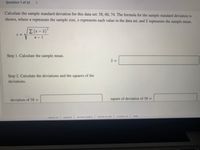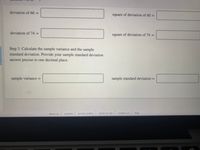
MATLAB: An Introduction with Applications
6th Edition
ISBN: 9781119256830
Author: Amos Gilat
Publisher: John Wiley & Sons Inc
expand_more
expand_more
format_list_bulleted
Question

Transcribed Image Text:Question 7 of 10
<>
Calculate the sample standard deviation for this data set: 58, 60, 74. The formula for the sample standard deviation is
shown, where n represents the sample size, x represents each value in the data set, and x represents the sample mean.
I (x – x)²
S =
n - 1
Step 1. Calculate the sample mean.
x =
Step 2. Calculate the deviations and the squares of the
deviations.
deviation of 58 =
square of deviation of 58 =
about us
careers privacy policy l terms of use
|contact us help

Transcribed Image Text:deviation of 60 =
square of deviation of 60 =
%3D
deviation of 74 =
square of deviation of 74 =
Step 3. Calculate the sample variance and the sample
standard deviation. Provide your sample standard deviation
answer precise to one decimal place.
sample variance =
sample standard deviation =
about us
I
privacy policy terms of use
contact us help
careers
Expert Solution
This question has been solved!
Explore an expertly crafted, step-by-step solution for a thorough understanding of key concepts.
This is a popular solution
Trending nowThis is a popular solution!
Step by stepSolved in 2 steps with 1 images

Knowledge Booster
Learn more about
Need a deep-dive on the concept behind this application? Look no further. Learn more about this topic, statistics and related others by exploring similar questions and additional content below.Similar questions
- You may change one number in the table if needed to make it work x -2 2 4 1 P(x=x) 0.21 -0.03 0.32 0.18 Give a 2-decimal answer for each: Mean Variance Standard Deviationarrow_forwardFind the range, the standard deviation, and the variance for the given samples. Round non-integer results to the nearest tenth. 75, 58, 61, 63, 48, 96, 49, 82, 97arrow_forwardPlayer His Average Points Other's Average Points Other's Standard Deviation Fredo 153 163 15 Karl 163 183 35 Table 2.57 a. Which player had the higher average points when compared to the other players on his team? Fredo O Karl b. Use Table 2.57 to find the value that is three standard deviations above the mean for each team. Enter the exact answers. Fredo's team: Number Karl's team: Number C. Use Table 2.57 to find the value that is three standard deviations below the mean for each team. Enter the exact answers. Fredo's team: Number Karl's team: Number Next Back Question Menu- Quit & Save Submit Assignment 502 PM 200arrow_forward
- The numbers of regular season wins for 10 football teams in a given season are given below. Determine the range, mean, variance, and standard deviation of the population data set. 2, 7, 15, 5, 14, 10, 12, 8, 3, 9 The range is 1313. (Simplify your answer.) The population mean is . (Simplify your answer. Round to the nearest tenth as needed.) The population variance is nothing. (Simplify your answer. Round to the nearest tenth as needed.) The population standard deviation is nothing. (Simplify your answer. Round to the nearest tenth as needed.)arrow_forwardCh 8 FRQ ( The distribution of average speeds of the top 53 drivers in NASCAR is roughly symmetric, unimodal, and bell-shaped, with a mean of 184.8 mph and a standard deviation of 7.2 mph. In the space above, draw a Normal Curve, from z=-3 to z=+3. Draw vertical lines at the mean and each whole number standard deviation above and below the mean. Write two rows of numbers under the base line; one row with the number of standard deviations above and below the mean (z-scores), and a row under that with the actual values for this problem. ] What percent of drivers would you expect to have speeds below 199.2 mph ? Show all work. s] What is the area under the curve to the left of a speed of 170.4mph Show all work. What is the probability that a driver selected at random will have a speed below 172.0 mph ? Show all work. B] What percent of drivers would you expect to have a speed above 177.0 mph ? Show all work. How many drivers would you expect to have speeds between 170.4 mph and 177.0 mph…arrow_forwardThe frequency distribution was obtained using a class width of 0.5 for data on cigarette tax rates. Use the frequency distribution to approximate the population mean and population standard deviation. Compare these results to the actual mean μ = $1.638 and standard deviation o = $1.052. Click the icon to view the frequency distribution for the tax rates. The population mean is $ (Round to three decimal places as needed.) book Get more help. C *** Frequency distribution of cigarette tax rates G Search or type URL Tax Rate 0.00-0.49 0.50-0.99 1.00-1.49 1.50-1.99 2.00-2.49 2.50-2.99 3.00-3.49 3.50-3.99 4.00-4.49 Print Frequency O 7 12 6 6 6 6 3 3 1 Done - X Clear all Check answerarrow_forward
- find the standard deviation step by step. that is find the deviation of each observation from the mean, square the deviations then obtain the variance and the standard deviation.i found the mean : 10.05i need help finding the standard deviation and the variancearrow_forwardFor the residents in 2014, use R to calculate the interval with 99% certainty that the interval contains the actual population mean of the residents by census tracts. Type in the interval with keyboard. We also know that in each year, the number of residents by census tract in the State of Maryland follows a normal distribution, and the variance in the number of residents within the State of Maryland is the same for different years. POP2014: 3072, 1989, 3794, 2689, 3211, 3722, 4385, 4009, 7598, 3862, 3097, 2726, 4881, 4157, 2570, 2512, 2518, 4863, 4147, 7139, 6067, 6819, 3705, 3239, 3824, 4977, 2576, 2940, 9791, 5231, 5634, 5337, 4205, 3888, 5562, 3335, 3770, 1808, 2045, 1532, 5420, 4993, 6109, 4377, 5424, 4976, 4507, 3738, 2827, 3485, 1559, 5199, 4702, 3971, 3803, 3356, 4670, 3816, 5477, 4760, 3126, 3630, 3755, 3795, 2578, 3382, 4005, 2442, 6096, 3799, 3843, 3836, 6046, 6431, 3561, 3142, 4829, 5058, 2471, 6119, 3523, 3094, 3146, 3356, 2618, 2366, 4266, 4016, 6080, 1554, 6878, 3645,…arrow_forwardThe coefficient of variation CV describes the standard deviation as a percent of the mean. Because it has no units, you can use the coefficient of variation to compare data with different units. Find the coefficient of variation for each sample data set. What can you conclude? Standard deviation CV = • 100% Mean E Click the icon to view the data sets. Data Table C/heights = 5.0 % (Round to the nearest tenth as needed.) Heights Weights CVweights =% (Round to the nearest tenth as needed.) 68 181 77 169 72 167 72 207 71 177 70 175 78 185 69 186 67 221 70 216 67 209 73 206arrow_forward
- I need range, variance, and standard deviation please with step by step so I can learn.arrow_forwardUse the dataset below to fill in the blanks. The space between the data and the blanks isprovided so that you can show each data value's deviation and each data value's deviation squared.Sixteen families were selected at random and the number of children in each was recorded 0 0 0 1 1 2 2 2 2 2 3 3 4 6 8 12arrow_forwardThe frequency distribution was obtained using a class width of 0.5 for data on cigarette tax rates. Use the frequency distribution to approximate the population mean and population standard deviation. Compare these results to the actual mean u = $1.506 and standard deviation o = $1.004. Click the icon to view the frequency distribution for the tax rates. Frequency distribution of cigarette tax rates Tax Rate Frequency 0.00–0.49 7 0.50-0.99 14 1.00–1.49 7 1.50–1.99 2.00–2.49 5 2.50–2.99 5 3.00–3.49 3.50–3.99 1 4.00-4.49 1arrow_forward
arrow_back_ios
SEE MORE QUESTIONS
arrow_forward_ios
Recommended textbooks for you
 MATLAB: An Introduction with ApplicationsStatisticsISBN:9781119256830Author:Amos GilatPublisher:John Wiley & Sons Inc
MATLAB: An Introduction with ApplicationsStatisticsISBN:9781119256830Author:Amos GilatPublisher:John Wiley & Sons Inc Probability and Statistics for Engineering and th...StatisticsISBN:9781305251809Author:Jay L. DevorePublisher:Cengage Learning
Probability and Statistics for Engineering and th...StatisticsISBN:9781305251809Author:Jay L. DevorePublisher:Cengage Learning Statistics for The Behavioral Sciences (MindTap C...StatisticsISBN:9781305504912Author:Frederick J Gravetter, Larry B. WallnauPublisher:Cengage Learning
Statistics for The Behavioral Sciences (MindTap C...StatisticsISBN:9781305504912Author:Frederick J Gravetter, Larry B. WallnauPublisher:Cengage Learning Elementary Statistics: Picturing the World (7th E...StatisticsISBN:9780134683416Author:Ron Larson, Betsy FarberPublisher:PEARSON
Elementary Statistics: Picturing the World (7th E...StatisticsISBN:9780134683416Author:Ron Larson, Betsy FarberPublisher:PEARSON The Basic Practice of StatisticsStatisticsISBN:9781319042578Author:David S. Moore, William I. Notz, Michael A. FlignerPublisher:W. H. Freeman
The Basic Practice of StatisticsStatisticsISBN:9781319042578Author:David S. Moore, William I. Notz, Michael A. FlignerPublisher:W. H. Freeman Introduction to the Practice of StatisticsStatisticsISBN:9781319013387Author:David S. Moore, George P. McCabe, Bruce A. CraigPublisher:W. H. Freeman
Introduction to the Practice of StatisticsStatisticsISBN:9781319013387Author:David S. Moore, George P. McCabe, Bruce A. CraigPublisher:W. H. Freeman

MATLAB: An Introduction with Applications
Statistics
ISBN:9781119256830
Author:Amos Gilat
Publisher:John Wiley & Sons Inc

Probability and Statistics for Engineering and th...
Statistics
ISBN:9781305251809
Author:Jay L. Devore
Publisher:Cengage Learning

Statistics for The Behavioral Sciences (MindTap C...
Statistics
ISBN:9781305504912
Author:Frederick J Gravetter, Larry B. Wallnau
Publisher:Cengage Learning

Elementary Statistics: Picturing the World (7th E...
Statistics
ISBN:9780134683416
Author:Ron Larson, Betsy Farber
Publisher:PEARSON

The Basic Practice of Statistics
Statistics
ISBN:9781319042578
Author:David S. Moore, William I. Notz, Michael A. Fligner
Publisher:W. H. Freeman

Introduction to the Practice of Statistics
Statistics
ISBN:9781319013387
Author:David S. Moore, George P. McCabe, Bruce A. Craig
Publisher:W. H. Freeman